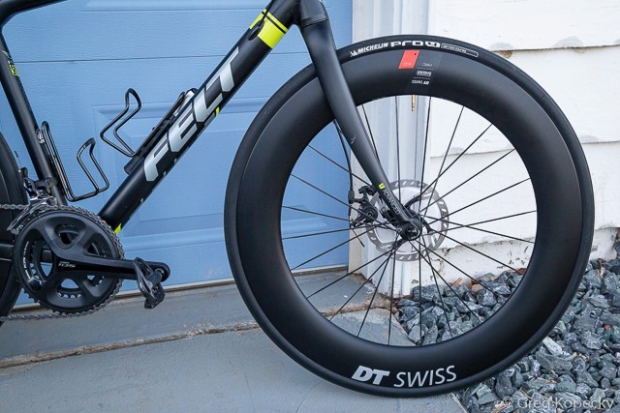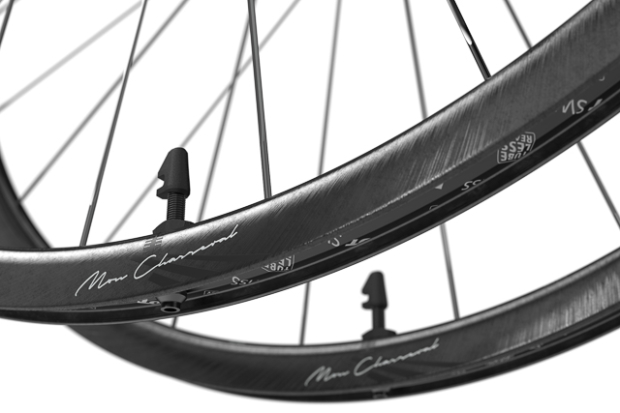DT Swiss ARC 1100 DICUT 80 Impressions
We recently shared the technical details and aero data for the latest aero wheel line from DT Swiss – the 2021 ARC series. DT touts upgrades all around over the previous generation, including improvements in aerodynamics, stability, rolling resistance, weight, and more. While the wheels don’t come cheap, they appear to be among the fastest wheels in the current marketplace – especially if you need to equip a 2020-model tri bike with disc brakes and 12mm thru axles.

DT sells three rim depths for the new wheels – 50mm, 62mm, and 80mm. They also have two different levels of hubs and spokes; the top-end 1100 series selling for $3,025 per pair, and the 1400 series for $2,479 (featuring identical rims). We had a chance to try out the most aerodynamic and fastest of the bunch – the ARC 1100 DICUT 80.

The ARC series uses standard hooked rims, which are tubeless-ready and have no restrictions on tire make or model. Rim width has increased to 20mm internal, over 17mm for the previous generation.

While DT normally sells the ARC series set up for 12mm thru axles (the latest axle trend for disc-brake-equipped triathlon and road bikes), they also have end caps for quick release skewers. My personal bike has rim brakes, but I was able to borrow a disc-equipped bike – which happened to have quick-release dropouts. DT graciously accommodated my needs, including a set of their unique thread-in-style skewers. They also include a set of tubeless valves… even with aero-style valve caps.

Upon initial setup, I was short on time and opted to toss on some standard clincher tires and tubes. I noticed that the valve holes seemed to be drilled on the smaller side, because most of my valve extenders would not fit (I tried Zipp and HED valve extenders, just to name a couple). The only brand that worked was Shimano, whose brass extenders are thinner than most. These got me on the road, and I was a happy boy.

With the wheels installed, the value of my borrowed bike roughly tripled, and I was on my way. Out on the road, the ARC 1100 DICUT 80’s performed without complaint. They gave the familiar loud clunk of each gear shift – which is a necessary result of such deep-and-hollow rims (which echo sound much more loudly than shallow-section rims). The build quality appeared to be superb, with zero finish problems or mechanical issues. DT has a reputation for quality, and my personal experience echoes that. Having owned many sets of DT rims, hubs, spokes, and wheels, I don’t know that I can recall a single failure outside of a serious accident.

DT’s technical presentation spoke at length about their improvements in wheel stability. The short explanation is that, by manipulating rim shape, it’s possible to affect the center-of-pressure for that push you feel from cross-winds – which can affect the amount of steering input caused by the wind. In other words – poorly designed wheels can steer your bike for you – which you must combat using your arm, shoulder, and neck muscles.

My two cents on the matter is this: I’ve ridden a tremendous amount of wheels of all shapes and sizes. I’m not arguing with the data presented with regards to wheel stability. My experience is that – in general – it just doesn’t really matter a lot in the real world. The key factor that drives how difficult a wheel is to ride in the wind is its surface area (i.e. the rim depth). More surface area ‘catches’ more wind, and creates more side force that you have to push back against. Whether or not there is a small amount of steering input along with this – to me – is imperceptible. Maybe I’m just not a particularly sensitive rider. If anything, wide modern wheels tend to be more difficult to handle, because they are so effective at keeping air attached and promoting the sailing effect – an aerodynamic benefit – which comes with a cost of more side force felt by the rider.
If it’s windy out, I personally just opt for a shallower front wheel to reduce the side force I’ll feel from each gust – making the bike easier to ride in the aero position. Side note: this is why smaller 650c wheels were preferred by many. The smaller diameter meant less surface area to create side force – which meant easier handling in all wind conditions.

I’m not picking on DT in any way with this discussion – just explaining my take on the situation after 18 years in the business. By all accounts, DT’s latest ARC series are legitimate high-end performers. They’re pricey, but in the same ballpark products like the Zipp 808 NSW Tubeless Disc Brake. If you can afford them and are in the market for wheels, they deserve a spot on your list. Personally, if I had a few grand burning a hole in my pocket (and a fully-funded 401k), I’d opt for the 1400 level, with a 62mm front rim and 80mm rear rim. This, to me, represents the best value proposition for the largest number of triathletes and roadies out there racing in the real world.







Start the discussion at forum.slowtwitch.com